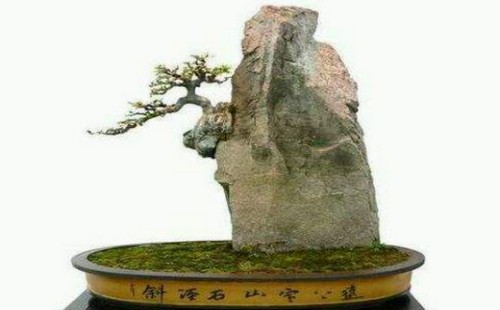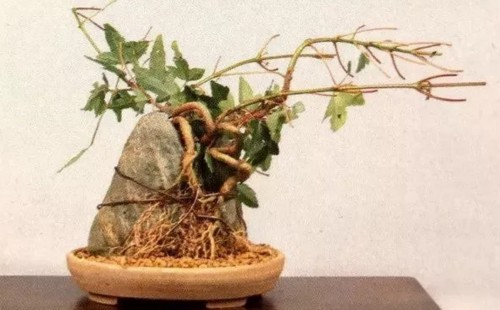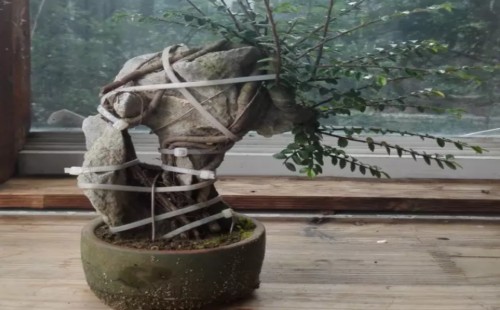How to fix the stone with stone bonsai
Stone bonsai is a perfect integration of stone and plant science. As a form of expression of potted plants, it can not only reflect the natural style, but also create a sense of beauty through integration. The stone-attached bonsai is generally planted on the stone, mainly through the root system of the plant to grasp the stone wall, and the root system of the plant can not only be completely attached to the stone, but also can be semi-attached to the stone, and the planting effect is different. Because of the plant species on the stone, from the point of view of load-bearing, we have to consider the stability of the stone. So, how to fix the stone with stone bonsai?

In the process of making stone-attached bonsai, it is very important to keep the stone stable all the time. If the stone is simply placed in the basin, the plants planted on the stone, especially the trees, may lose their center of gravity and cause the stone to dump together with the plants, thus destroying the original beautiful shape. Therefore, fixing the stone is the top priority.
The stone-attached bonsai is based on stone, the trees are attached to the stone to keep growing, and the trees and stones form a unified whole. In order to keep this overall balance from being broken, we need to fix the stone firmly on the basin surface. But stone-attached bonsai can be divided into water-attached stone and dry-attached stone. For the water-attached stone bonsai, first of all, there must be certain requirements in the choice of stone, on the one hand, the stone needs to have a certain weight to facilitate fixation, on the other hand, it has a certain water absorption and water retention capacity, and plants are planted on the stone. in addition, the stone wall should be suitable for the climbing of plant roots. It is recommended to use water-absorbing stones, sand stones and other materials.
And if it is to make dry-attached bonsai, generally use hard stones such as Yingde stone with various textures, the original is mainly to let the roots of plants take root among them, which is not only easy to grasp, but also easy to shape. However, whether it is to make water-attached stone bonsai or dry-attached stone bonsai, we need to firmly fix the stone on the basin surface to avoid capsizing due to the deviation of the upper gravity and the center of gravity. The more common practice is to use cement river sand according to a certain proportion into a strong viscosity adhesive, so that the stone and basin firmly stick together. Of course, if necessary, we can also fix it with the help of iron wire.
However, some merchants create a shiny and smooth surface on the basin in order to improve the ornamental value of the basin, which is very disadvantageous to fix the stone on the basin, especially the porcelain basin, which is often more difficult to fix the stone. So, in this case, we might as well try to change our thinking. First, make a large and heavy base for the stone used in the stone bonsai, and then put it in the pot, so that it is not easy to dump due to the instability of the center of gravity caused by the green plant above.
But doing so will also encounter a problem, that is, how to make the stone firmly bonded to the base without falling off. In addition to the use of iron wire to fix the two, it is often necessary to simply glue the two with the help of epoxy resin adhesive. After all, the use of iron wire to fix the two will create a lot of gaps, and the use of wire fixation will also affect the appearance. Therefore, generally speaking, the two can be bonded directly with epoxy resin adhesive.
If there is no epoxy resin adhesive, we can also use dolomite glue to bond. Dolomite glue is based on unsaturated polyester resin, which has a good effect of solidifying stone, and it is easy to operate and can dry quickly, so it is very suitable for bonding, repairing and filling joints between stones. And this material has strong stickiness and good resistance to external forces, so it is very good to use it to fix stones in the process of making stone-attached bonsai.
Of course, there is a relatively rough way to fix the stone here, which is to fix the stone and basin with wire. First select a shallow basin with multiple holes at the bottom, then lay a layer of barbed wire on the bottom of the basin, and then use wire to fix the stone from the hole and barbed wire passing through the bottom of the basin. But for the sake of beauty, the gap between the two can be glued together. Although this method looks rough, it lacks the ability to fix the stone well. You might as well give it a try!
Time: 2019-06-03 Click:
- Prev

How to make semi-stone bonsai
Stone-attached bonsai is a bonsai display form that integrates plants and stones. Usually, stone-attached bonsai can be divided into two forms: full stone-attached and semi-stone-attached. A fully attached stone is a tree root that is all attached to a stone, while a semi-attached stone is a tree root that can grow only by holding the stone.
- Next

How to attach stone to elm tree-the method of making bonsai with stone on elm tree
In the growing season of elm bonsai, there are often many new branches, and even a lot of overgrown branches, so we need to do a good pruning treatment in time to prevent the new branches from destroying the original beautiful shape of the bonsai. But it often takes about 5 years from young elm to bonsai to take shape.
Related
- Fuxing push coffee new agricultural production and marketing class: lack of small-scale processing plants
- Jujube rice field leisure farm deep ploughing Yilan for five years to create a space for organic food and play
- Nongyu Farm-A trial of organic papaya for brave women with advanced technology
- Four points for attention in the prevention and control of diseases and insect pests of edible fungi
- How to add nutrient solution to Edible Fungi
- Is there any good way to control edible fungus mites?
- Open Inoculation Technology of Edible Fungi
- Is there any clever way to use fertilizer for edible fungus in winter?
- What agents are used to kill the pathogens of edible fungi in the mushroom shed?
- Rapid drying of Edible Fungi

